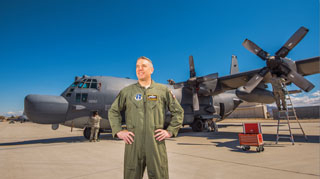
Clark Highstrete has walked two paths in his professional life. One went toward science and led to physics research at Sandia. The other went to the skies and a career as an Air Force pilot.
Clark works in Sandia’s Quantum Information Sciences Dept. 5643 and is a colonel in the New Mexico Air National Guard with more than 2,500 flying hours including 200 in combat in Bosnia and Iraq. He recently assumed command of the Guard’s 150th Fighter Wing at Kirtland Air Force Base, made up of more than 900 airmen. He previously was director of operations for the New Mexico Air National Guard, responsible for strategic planning and policy, and oversight and guidance for its missions.
“Science and the Air Force have both been very rewarding parts of my professional life,” Clark says. “I’ve been fortunate to have such fantastic opportunities on both sides.”
The 150th Fighter Wing, whose missions involve security police, logistics, and medical services, has been known since its days in Vietnam as the Tacos. The Tacos’ F-16 fighter jets were transferred to other fighter wings in 2010 when the Pentagon opted to speed up retirement of its fourth-generation fighters in favor of fifth-generation stealth fighters.
Since then the 150th has taken on four new missions, including a merger with Kirtland’s 58th Special Operations Wing, training crews on MC/HC-130 aircraft and two types of helicopters. The 150th also picked up a rapidly deployable engineering unit known as Red Horse and an Intelligence Target Production Center that does imagery and computer analysis for target planning.
Quantum information
Clark says he has long felt the pull of two professions.
He graduated from the California Institute of Technology in 1989 with a bachelor’s degree in applied physics. He was commissioned out of college by the University of Southern California ROTC program and served on active duty from 1990 to 2000. He first completed pilot training, but there weren’t a lot of flying assignments at that time. He was assigned to use his physics degree in acquisition management at Los Angeles Air Force Base. He also did an internship in physics research with Aerospace Corp.
Clark was called back to fly and served from 1993 to 2000 as an F-16 pilot, mission commander, and instructor pilot. He left the Air Force to attend graduate school in New Mexico. “I had two very distinct interests,” Clark says. “I was interested in flying and military service. I also wanted to pursue a science career. I thought the best mix for me was to continue doing the operational military role as a citizen airman in the Air National Guard. I could do that part time and pursue a scientific career on the civilian side. I also wanted to dedicate my technical work toward national security, so New Mexico was a logical choice.”
Clark joined the Guard in Albuquerque as a full-time instructor then went to traditional part-time status to begin graduate school. He earned a master’s of science and a doctorate in physics from the University of New Mexico. He joined Sandia in 2004 as a student intern, followed by a postdoctoral fellowship. He became a full-time Sandia staff member in 2010.
“I have a pretty diverse background in physics,” Clark says. He started graduate school in quantum information sciences and did his Sandia internship in solid-state physics examining high-frequency electronic properties of nanomaterials. At Sandia his research also has included ion trapping for quantum information science applications. He now does a mix of research and program management in a variety of technical areas.
Pave the way
Clark’s post as 150th Fighter Wing commander is part time. “The traditional guardsman is the cornerstone of the National Guard,” he says. “The central principle is the militia construct provided in the Constitution and realized in the National Guard.”
Clark says his vision and motivation throughout his military career have been to take on challenges that reinforce the importance of the traditional Guard member in US society. “Taking on leadership roles and more challenges requires more effort, but I look to that to set an example of what a traditional guardsman can and should be,” he says.
He says his role as Wing commander is the ultimate test of that. “Part of the challenge I was given was to pave the way, to show how it can be done,” he says. “We haven’t had a traditional commander in recent memory. Our New Mexico guardsmen are all highly dedicated, selfless, and professional airmen. The adjutant general has made the service of our traditional Guard members in particular a top priority. What better way to emphasize and realize that priority than to have a traditional guardsman as a commander?”
He says his dual path is possible because of the support of an excellent staff and vice commander, Col. Joel Harris, and the enthusiastic support of his Sandia management. “Sandia is exceptional in its support of the Guard and Reserves,” he says. “I have been consistently supported throughout my Air National Guard service. Without that, I could not have done it.”